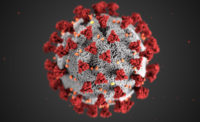Preventing food recalls from becoming the new normal

Food safety is a topic that is top-of-mind for consumers, especially with so many food recalls in the news eliciting fear. According to the International Food Information Council (IFIC) Foundation’s 2018 Food and Health Survey, when ranking their top three food safety concerns, 54 percent of consumers chose “foodborne illness from bacteria“ – equal to those who selected “carcinogens or cancer-causing chemicals” and “chemicals in food.”
An often-overlooked category is low-moisture foods, such as nuts, seeds and grains. While generally low-risk, pathogenic microorganisms such as Salmonella and E.coli can survive under dry conditions for several months or even years. Flour falls into this category and is a top three kitchen staple, with continued recalls year after year. The industry is primed for a solution.
Dramatic increase in flour recalls
According to the U.S. Food and Drug Administration (FDA), there have been 14 flour recalls in 2019 alone due to the presence or potential presence of pathogens including E. coli and Salmonella. This is a marked increase over 2018 numbers, although 2017 had a number of large and highly visible recalls. Recalls span multiple brands and production facilities and represent enormous quantities of flour that contain harmful pathogens. As of October, The Centers for Disease Control and Prevention(CSCP) was investigating a flour-related outbreak of E. coli O26. Seventeen people fell ill in eight states, and three were hospitalized. So how does this keep happening over and over again at such a large scale?
Pathogens in flour
Contamination isn’t believed to occur during the production process. Researchers hypothesize that contaminated wheat fields are the likely cause. Samuel J. Crowe, Ph.D., M.P.H., an epidemiologist at the Centers for Disease Control and Prevention (CDC) and the lead author of a study published in The New England Journal of Medicine in 2017, stated in an interview that “these pathogens [E. coli] live naturally in certain animals such as cows and deer, and these animals and their feces are frequently found in wheat fields. Whenever combines [machines that harvest grain] come through and churn up the wheat to separate it out for processing, they also can pull up some of the feces and other contaminants.” After grain is harvested, it is taken to specialized facilities where grain is milled. While there are a number of steps in the milling process intended to increase product quality through cleaning and separating, there has been no standardized process step to control harmful pathogens prior to getting it consumer package-ready. Therefore, industry and public health organizations state that flour is not a ready-to-eat product and must be cooked prior to destroy pathogens in the flour and to prevent food-borne illnesses. But, given the significant volumes of flour that are being sold and consumed on a daily basis, it is difficult for every home and restaurant kitchen to vigilantly ensure this product is handled properly.
Cost of recalls
As a result, tens of thousands of bags of flour have been removed from grocery stores nationwide, costing brands anywhere from $10 million to $30 million per recall to cover activities such as communicating across the supply chain, retrieving and handling the recalled product, investigating the event and implementing corrective actions to prevent re-occurrence. The more damaging results, however, have been the breach of trust in the brands and worst—the sickness and hospitalization of consumers who ingested the tainted flour. While recalls are always difficult, they are particularly challenging in the flour category as many consumers store flour in a container without the packaging; this creates complexity in remembering the brand, lot numbers and “use by” dates.
Common ways consumers are exposed to contaminants
Contamination is a real threat as raw flour may spread easily due to its powdery nature. All surfaces, hands and utensils that come into contact with flour or dough should be properly cleaned to eliminate pathogens. In addition, while FoodSafety.gov states that raw dough and batter are not considered safe to eat, many consumers sample dough and batter as part of the baking process. In addition, children have become sick through playing with raw pizza dough and other flour-based arts and crafts projects as a result of working with flour that has been contaminated. Additional challenges arise due to the long pantry life of products. The CDC warns that “consumers who don’t know about the recalls could continue to eat the products and get sick.”
Solutions
Manufacturers, brands, retailers and other stakeholders in the value chain have actively sought ways to eliminate pathogens in flour. Some have tried to combat contamination through heat treatment of flour; however, this process has remained a niche solution due to several factors. These include the associated high capital costs and manufacturing footprint of equipment, additional steps required in the milling process, and negative effects on flour’s visco-elastic gluten properties, which is needed for baked goods, like bread, to rise.
Others, like our company, Agri-Neo, have looked at it from a different point of view. In order to keep costs as low as possible and ensure widespread industry adoption, we have explored solutions within existing systems and processes, specifically the tempering step, to control pathogens in hard and soft flours. We are in the process of commercializing Neo-Temper, an organic liquid solution that is mixed with the water deployed during the tempering process. This technique uniformly destroys pathogens, such as Salmonella, E. coli and Listeria on the wheatberry’s surface and in cracks and crevices that can harbor pathogens. Once the process is complete, the liquid solution completely biodegrades leaving the food safe for consumption while maintaining the nutritional and functional qualities of treated flours. We have validated this approach at multiple commercial flour mills, in conditions that represent everyday operation—a process so innovative that we have filed patents around the validation methodology.
Food safety is a fundamental standard that consumers value and expect from manufacturers. Now, more than ever, brands have the resources needed to address flour safety proactively, and, in doing so, have the opportunity to establish and reinforce their position as industry leaders.
But even more than a preventative safety measure, companies implementing technologies to improve safety can create a value-added differentiator. This also could potentially grow market share and retail revenue through a proven, trusted and tested consumer benefit that addresses broader consumer concerns about food safety protocols.
Looking for a reprint of this article?
From high-res PDFs to custom plaques, order your copy today!








